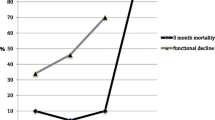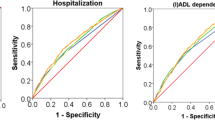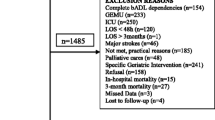Abstract
Objectives
To determine the usefulness of physical phenotype of frailty, cognitive impairment, and serum albumin for risk stratification of elderly medical impatients.
Design
Prospective, observational cohort study.
Setting
A general internal medicine unit of a university hospital in Italy.
Participants
Inpatients with an average age of 80.8 ± 7.5 yr (N=470).
Measurements
Frailty was defined using the Study of Osteoporotic Fractures Index, a parsimonious version of the physical phenotype (two of the following markers: weight loss, inability to rise five times from a chair, and exhaustion). Two frailty markers from non-physical dimensions were also evaluated: cognitive impairment (Mini-Cog score < 3) and low serum albumin on ward admission (< 3,5 gr/dl). Logistic regression adjusted for preadmission and admission-related confounders was used to investigate whether the physical phenotype of frailty and the two non-physical markers were associated with ward length of stay and unfavorable discharge (death plus any other ward discharge disposition different from direct return home). Areas Under the receiver operating characteristic Curve (AUCs) and Likelihood Ratios (LRs) were used for evaluation of discriminatory ability and clinical usefulness of significant predictors.
Results
The physical phenotype of frailty was associated with both study outcomes (p<0.010) but the association was mainly mediated by chair standing ability. Non-physical markers were associated only with unfavourable discharge (p<0.001). All of these predictors, either alone or in combination, had poor discriminatory ability (AUCs < 0.70) and poor clinical usefulness (+LRs near 1) for the study outcomes.
Conclusions
The physical phenotype of frailty appears of limited clinical use for risk stratification of older medical inpatients. Combination with markers from nonphysical dimensions does not improve its prognostic abilities.
Similar content being viewed by others
References
Campbell SE, Seymour DG, Primrose WR. A systematic literature review of factors affecting outcome in older medical patients admitted to hospital. Age Ageing 2004;33:110–115
Anpalahan M, Gibson SJ. Geriatric syndromes as predictors of adverse outcomes of hospitalization. Intern Med J 2008;38:16–23
Lafont C, Gérard S, Voisin T, Pahor M, Vellas B. Reducing «iatrogenic disability» in the hospitalized frail elderly. J Nutr Health Aging 2011;15:645–660
De Saint-Hubert M, Schoevaerdts D, Cornette P, D’Hoore W, Boland B, Swine C. Predicting functional adverse outcomes in hospitalized older patients: a systematic review of screening tools. J Nutr Health Aging 2010;14:394–399
Covinsky KE, Pierluissi E, Johnston CB. Hospitalization-associated disability: “She was probably able to ambulate, but I’m not sure.” JAMA 2011;306:1782–1793
Fried LP, Tangen CM, Walston J, et al. Frailty in older adults: evidence for a phenotype. J Gerontol A Biol Sci Med Sci 2001;56:M146–156
Sternberg SA, Wershof Schwartz A, Karunananthan S, Bergman H, Mark Clarfield A. The identification of frailty: a systematic literature review. J Am Geriatr Soc 2011;59:2129–2138
Moreno-Aguilar M, Garcia-Lara JMA, Aguilar-Navarro S, Navarrete-Reyes AP, Amieva H, Avila-Funes JA. The phenotype of frailty and health-related quality of life. J Frailty Aging 2013;2:2–7
Partridge JSL, Harari D, Dhesi JK. Frailty in the older surgical patient: a review. Age Ageing 2012;41:142–147
Purser JL, Kuchibhatla MN, Fillenbaum GG, Harding T, Peterson ED, Alexander KP. Identifying frailty in hospitalized older adults with significant coronary artery disease. J Am Geriatr Soc 2006;54:1674–1681
Ekerstad N, Swahn E, Janzon M, et al. Frailty is independently associated with shortterm outcomes for elderly patients with non-ST-segment elevation myocardial infarction. Circulation 2011;124:2397–2404
Pilotto A, Rengo F, Marchionni N, et al. Comparing the prognostic accuracy for allcause mortality of frailty instruments: a multicentre 1-year follow-up in hospitalized older patients, 2012. PLoS One doi: 10.1371/journal.pone.0029090
Khandelwal D, Goel A, Kumar U, Gulati V, Narang R, Dey AB. Frailty is associated with longer hospital stay and increased mortality in hospitalized older patients. J Nutr Health Aging 2012;16:732–735
Rodríguez-Mañas L, Féart C, Mann G, et al. Searching for an operational definition of frailty: a Delphi method based consensus statement: the frailty operative definition-consensus conference project. J Gerontol A Biol Sci Med Sci 2013;68:62–67
Scanlan J, Borson S. The Mini-Cog: receiver operating characteristics with expert and naïve raters. Int J Geriatr Psychiatry 2001;16:216–222
Ahmed N, Mandel R, Fain MJ. Frailty: an emerging geriatric syndrome. Am J Med 2007;120:748–753
Robinson TN, Wallace JI, Wu DS, et al. Accumulated frailty characteristics predict postoperative discharge institutionalization in the geriatric patient. J Am Coll Surg 2011;213:37–42
Green P, Woglom AE, Genereux P, et al. The impact of frailty status on survival after transcatheter aortic valve replacement in older adults with severe aortic stenosis: a single-center experience. JACC Cardiovasc Interv 2012;5:974–981
Friedman AN, Fadem SZ. Reassessment of albumin as a nutritional marker in kidney disease. J Am Soc Nephrol 2010;21:223–230
Ensrud KE, Ewing SK, Cawthon PM, et al. A comparison of frailty indexes for the prediction of falls, disability, fractures, and mortality in older men. J Am Geriatr Soc 2009;57:492–498
Kiely DK, Cupples LA, Lipsitz LA. Validation and comparison of two frailty indexes: The MOBILIZE Boston Study. J Am Geriatr Soc 2009;57:1532–1539
Ostir GV, Berges I, Kuo YF, Goodwin JS, Ottenbacher KJ, Guralnik JM. Assessing gait speed in acutely ill older patients admitted to an acute care for elders hospital unit. Arch Intern Med 2012;172:353–358
Koennecke HC, Belz W, Berfelde D, et al. Factors influencing in-hospital mortality and morbidity in patients treated on a stroke unit. Neurology 2011;77:965–972
Charlson ME, Pompei P, Ales KL, MacKenzie CR. A new method of classifying prognostic comorbidity in longitudinal studies: development and validation. J Chronic Dis 1987;40:373–383
Katz S, Downs TD, Cash HR, Grotz RC. Progress in development of the index of ADL. Gerontologist 1970;10:20–30
Hoyl MT, Alessi CA, Harker JO, et al. Development and testing of a five-item version of the Geriatric Depression Scale. J Am Geriatr Soc 1999;47:873–878
Subbe CP, Kruger M, Rutherford P, Gemmel L. Validation of a modified Early ai]Warning Score in medical admissions. QJM 2001;94:521–526
Peat J. Health science research: A handbook of quantitative methods. Allen & Unwin, Sydney, 2001.
Swets JA. Measuring the accuracy of diagnostic systems. Science 1988;240:1285–1293
Hayden SR, Brown MD. Likelihood ratio: A powerful tool for incorporating the results of a diagnostic test into clinical decision-making. Ann Emerg Med 1999;33:575–580
McGee S. Simplifying likelihood ratios. J Gen Intern Med 2002;17:646–649
Wou F, Gladman JR, Bradshaw L, Franklin M, Edmans J, Conroy SP. The predictive properties of frailty-rating scales in the acute medical unit. Age Ageing 2013;42:776–781
Sourial N, Bergman H, Karunananthan S, et al. Contribution of frailty markers in explaining differences among individuals in five samples of older persons. J Gerontol A Biol Sci Med Sci 2012;67:1197–1204.
Peel NM, Kuys SS, Klein K. Gait speed as a measure in geriatric assessment in clinical settings: a systematic review. J Gerontol A Biol Sci Med Sci 2013;68:39–46
Cooper R, Kuh D, Cooper C, Gale CR, Lawlor DA, Matthews F, Hardy R. Objective measures of physical capability and subsequent health: a systematic review. Age Ageing 2011;40:14–23
Fisher SR, Ottenbacher KJ, Goodwin JS, Ostir GV. Chair rise ability and length of stay in hospitalized older adults. J Am Geriatr Soc 2009;57:1938–1940
Sartori AC, Vance DE, Slater LZ, Crowe M. The impact of inflammation on cognitive function in older adults: implications for healthcare practice and research. J Neurosci Nurs 2012;44:206–217
Pijpers E, Ferreira I, Stehouwer CDA, Nieuwenhuijzen Kruseman AC. The frailty dilemma. Review of the predictive accuracy of major frailty scores. Eur J Intern Med 2012;23:118–123
Sourial N, Bergman H, Karunananthan S, et al. Implementing Frailty Into Clinical Practice: A Cautionary Tale. J Gerontol A Biol Sci Med Sci 2013;68:1505–1511
Salvi F, Morichi V, Grilli A, et al. Screening for frailty in elderly emergency department patients by using the Identification of Seniors At Risk (ISAR). J Nutr Health Aging 2012;16:313–318
Launay CP, Annweiler C, De Decker L, Kabeshova A, Fantino B, Beauchet O. Risk of in-hospital mortality following emergency department admission: Results from the geriatric EDEN cohort study. J Nutr Health Aging 2014;1:83–86
McCusker J, Kakuma R, Abrahamowicz M. Predictors of functional decline in hospitalized elderly patients: a systematic review. J Gerontol A Biol Sci Med Sci 2002;57:M569–577
Vellas B, Balardy L, Gillette-Guyonnet S, et al. Looking for frailty in communitydwelling older persons: The Gerontopole Frailty Screening Tool (GSFT) J Nutr Health Aging 2013;17:629–631
Author information
Authors and Affiliations
Corresponding author
Rights and permissions
About this article
Cite this article
Forti, P., Maioli, F., Zagni, E. et al. The physical phenotype of frailty for risk stratification of older medical inpatients. J Nutr Health Aging 18, 912–918 (2014). https://doi.org/10.1007/s12603-014-0493-5
Received:
Accepted:
Published:
Issue Date:
DOI: https://doi.org/10.1007/s12603-014-0493-5




